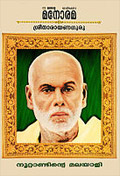Concerning the caste system, Gandhi said the following to Nārāyana Guru: "The caste-Hindus and the low caste-Hindus are both the sons of Hinduism. The caste-Hindu is the elder brother who shoulders responsibility, and he therefore exercises certain privileges. The low caste-Hindu is his younger brother who is to be cared for. If the elder brother turns out to be somewhat rough and aggressive that should not make the younger brother a runaway from his mother Hinduism.”
Nārāyana Guru, however, disagreed, and voiced his tolerance for those who converted to other religions, with the argument that one should follow what one truly believes in. He also questioned the logic of Gandhi’s argument, arguing that caste in India was a socio-economic issue.
Public acceptance, honours and veneration
 Nārāyana Guru has been conferred many formal recognitions and honours by the State, intelligentsia and society. In 1901 the State Census Manual of Travancore recorded Shree Nārāyana as a revered "Guru” and an erudite Sanskrit scholar. A sharp drop in the statistics of the commission of crime was also attributed to the correcting and moralizing influence of Nārāyana Guru on the society. In 1904, the then Maharajah of Travancore exempted Nārāyana Guru from personal appearances in court, an honour recognizing the Guru as a distinguished living personality.
Nārāyana Guru has been conferred many formal recognitions and honours by the State, intelligentsia and society. In 1901 the State Census Manual of Travancore recorded Shree Nārāyana as a revered "Guru” and an erudite Sanskrit scholar. A sharp drop in the statistics of the commission of crime was also attributed to the correcting and moralizing influence of Nārāyana Guru on the society. In 1904, the then Maharajah of Travancore exempted Nārāyana Guru from personal appearances in court, an honour recognizing the Guru as a distinguished living personality.
Malayala Manorama cover spread on 31 December 1999 naming Nārāyana Guru as ‘Malayalee of the Century’.
 The first statue of the Guru was conceived by Moorkoth Kumaran and sculpted by an Italian sculptor Prof. Tavaroli whilst the Guru was still alive. The bronze statue, which took 14 months to complete, was installed at the Jaggannaatha temple at Thalassery and unveiled on 13 March 1927, after the consecration of the statue by Bodhananda Swamikal, the disciple and then spiritual successor-designate to Nārāyana Guru.
The first statue of the Guru was conceived by Moorkoth Kumaran and sculpted by an Italian sculptor Prof. Tavaroli whilst the Guru was still alive. The bronze statue, which took 14 months to complete, was installed at the Jaggannaatha temple at Thalassery and unveiled on 13 March 1927, after the consecration of the statue by Bodhananda Swamikal, the disciple and then spiritual successor-designate to Nārāyana Guru.
On the Guru’s death, the famed Jnanapith award winner poet Mahakavi G. Sankara Kurup paid tribute to Nārāyana Guru by writing a Malayalam verse venerating the Guru as The Second Buddha. Shree Nārāyana Guru’s legacy continues to be revered at esteemed levels within social, intellectual and spiritually organized communities worldwide.
Jagadguru Swami Sathyananda Saraswathi,the renowned spiritual teacher reckoned as the greatest karmayogi to uphold Sanatana Dharma since Swami Vivekananda drew inspiration from the Guru’s life and teachings and popularised it through his long oratories across the length and breadth of Kerala. He can be regarded as a political successor of the guru who enshrined the guru’s vision in the setting up the Hindu Aikya Vedi uniting all the Hindu organisations in Kerala under the aegis of a single organisation brushing aside caste distinctions and uniting the two major groups of Hindus in the state, the savarna Nairs and Ezhavas.
All across the State of Kerala, and outside the State, hundreds of small chapel-like Guru Mandirams are devoted to the reverence and worship of Shree Nārāyana Guru. Most recently, a distinctively styled iconographic statue of Nārāyana Guru named the Jnana Vigraham was conceived and created by a team of artists, as a suggestive model for the future, to improve the aesthetic quality of statues of Nārāyana Guru kept in homes and placed in Guru Mandirams worldwide.
The International Center for Shree Narayana Guru Studies was established in 2005. On the website, the Center attributes 20 miracles to him.
Saint Disciples Of Guru
- Sree Bodhananda Swamikal
- Nataraja Guru